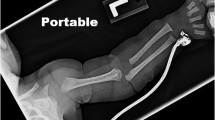Abstract
The spondylo and spondylometaphyseal dysplasias (SMDs) are characterized by vertebral changes and metaphyseal abnormalities of the tubular bones, which produce a phenotypic spectrum of disorders from the mild autosomal-dominant brachyolmia to SMD Kozlowski to autosomal-dominant metatropic dysplasia. Investigations have recently drawn on the similar radiographic features of those conditions to define a new family of skeletal dysplasias caused by mutations in the transient receptor potential cation channel vanilloid 4 (TRPV4). This review demonstrates the significance of radiography in the discovery of a new bone dysplasia family due to mutations in a single gene.












Similar content being viewed by others
References
Krakow D, Rimoin DL (2010) The skeletal dysplasias. Genet Med 12:327–341
Warman ML, Cormier-Daire V, Hall C et al (2011) Nosology and classification of genetic skeletal disorders: 2010 revision. Am J Med Genet A 155A:943–968
Lachman RS, Tiller GE, Graham JM Jr et al (1992) Collagen, genes and the skeletal dysplasias on the edge of a new era: a review and update. Eur J Radiol 14:1–10
Spranger J, Winterpacht A, Zabel B (1993) The type II collagenopathies: a spectrum of chondrodysplasias. Eur J Pediatr 153:56–65
Superti-Furga A, Hästbacka J, Rossi A (1996) A family of chondrodysplasias caused by mutations in the diastrophic dysplasia sulfate transporter gene and associated with impaired sulfation of proteoglycans. Ann N Y Acad Sci 785:195–201
Krakow D, Robertson SP, King LM et al (2004) Mutations in the gene encoding filamin B disrupt vertebral segmentation, joint formation and skeletogenesis. Nat Genet 36:405–410
Rock MJ, Prenen J, Funari VA et al (2008) Gain-of-function mutations in TRPV4 cause autosomal dominant brachyolmia. Nat Genet 40:999–1003
Krakow D, Vriens J, Camacho N et al (2008) Mutations in the gene encoding the calcium-permeable ion channel TRPV4 produce spondylometaphyseal dysplasia, Kozlowski type and metatropic dysplasia. Am J Hum Genet 84:307–315
Dai J, Kim OH, Cho TJ et al (2010) Novel and recurrent TRPV4 mutations and their association with distinct phenotypes within the TRPV4 dysplasia family. J Med Genet 47:704–709
Dai J, Cho TJ, Unger S et al (2010) TRPV4-pathy, a novel channelopathy affecting diverse systems. J Hum Genet 55:400–402
Mourão PA, Toledo SP, Nader HB et al (1973) Excretion of chondroitin sulfate C with low sulfate content by patients with generalized platyspondyly (brachyolmia). Biochem Med 7:415–423
Shohat M, Lachman R, Gruber HE et al (1989) Brachyolmia: radiographic and genetic evidence of heterogeneity. Am J Med Genet 33:209–219
Gardner J, Beighton P (1994) Brachyolmia: an autosomal dominant form. Am J Med Genet 49:308–312
Kozlowski K, Maroteaux P, Spranger JW (1967) La dysostose spondylometaphysaire. Presse Med 75:2769
Lachman RS (2007) Spondylometaphyseal dysplasia, Kozlowski type (SMD Kozlowski). In: Taybi & Lachman’s Radiology of syndromes, metabolic disorders and skeletal dysplasias, 5th edn. Mosby, Elsevier, Philadelphia, pp 1080–1085
Maroteaux P, Spranger J, Wiedemann HR (1966) Metatrophic dwarfism. Arch Kinderheilkd 173:211–226
Geneviève D, Le Merrer M, Feingold J et al (2008) Revisiting metatropic dysplasia: presentation of a series of 19 novel patients and review of the literature. Am J Med Genet A 146:992–996
Lachman RS (2007) Brachyolmia. In: Taybi & Lachman’s Radiology of syndromes, metabolic disorders and skeletal dysplasias, 5th edn. Mosby, Elsevier, Philadelphia, pp 891–892
Camacho N, Krakow D, Johnykutty S et al (2010) Dominant TRPV4 mutations in nonlethal and lethal metatropic dysplasia. Am J Med Genet A 152:1169–1177
Lachman RS (2007) Metatropic dysplasia. In: Taybi & Lachman’s Radiology of syndromes, metabolic disorders and skeletal dysplasias, 5th edn. Mosby, Elsevier, Philadelphia, pp 1000–1001
Murray LW, Bautista J, James PL et al (1989) Type II collagen defects in the chondrodysplasias. I. Spondyloepiphyseal dysplasias. Am J Hum Genet 45:5–15
Hästbacka J, Superti-Furga A, Wilcox WR et al (1996) Atelosteogenesis type II is caused by mutations in the diastrophic dysplasia sulfate-transporter gene (DTDST): evidence for a phenotypic series involving three chondrodysplasias. Am J Hum Genet 58:255–262
Farrington-Rock C, Firestein MH, Bicknell LS et al (2006) Mutations in two regions of FLNB result in atelosteogenesis I and III. Hum Mutat 27:705–710
Cohn DH (1996) Mutations affecting multiple functional domains of FGFR3 cause different skeletal dysplasias: a personal retrospective in honor of John Wasmuth. Ann N Y Acad Sci 785:160–163
Savarirayan R, White SM, Goodman FR et al (2003) Broad phenotypic spectrum caused by an identical heterozygous CDMP-1 mutation in three unrelated families. Am J Med Genet A 117:136–142
Guilak F, Leddy HA, Liedtke W (2010) Transient receptor potential vanilloid 4: The sixth sense of the musculoskeletal system? Ann N Y Acad Sci 1192:404–409
Masuyama R, Vriens J, Voets T et al (2008) TRPV4-mediated calcium influx regulates terminal differentiation of osteoclasts. Cell Metab 8:257–265
Nishimura G, Dai J, Lausch E et al (2010) Spondylo-epiphyseal dysplasia, Maroteaux type (pseudo-Morquio syndrome type 2), and parastremmatic dysplasia are caused by TRPV4 mutations. Am J Med Genet A 152:1443–1449
Auer-Grumbach M, Olschewski A, Papić L et al (2010) Alterations in the ankyrin domain of TRPV4 cause congenital distal SMA, scapuloperoneal SMA and HMSN2C. Nat Genet 42:160–164
Acknowledgment
The authors wish to thank Ms. Mary McAllister (John Hopkins University, Baltimore, MD) for her assistance in editing the manuscript. This work has been supported by a grant from the National Institutes of Health (5P01 HD022657-25).
Author information
Authors and Affiliations
Corresponding author
Rights and permissions
About this article
Cite this article
Nemec, S.F., Cohn, D.H., Krakow, D. et al. The importance of conventional radiography in the mutational analysis of skeletal dysplasias (the TRPV4 mutational family). Pediatr Radiol 42, 15–23 (2012). https://doi.org/10.1007/s00247-011-2229-6
Received:
Revised:
Accepted:
Published:
Issue Date:
DOI: https://doi.org/10.1007/s00247-011-2229-6




